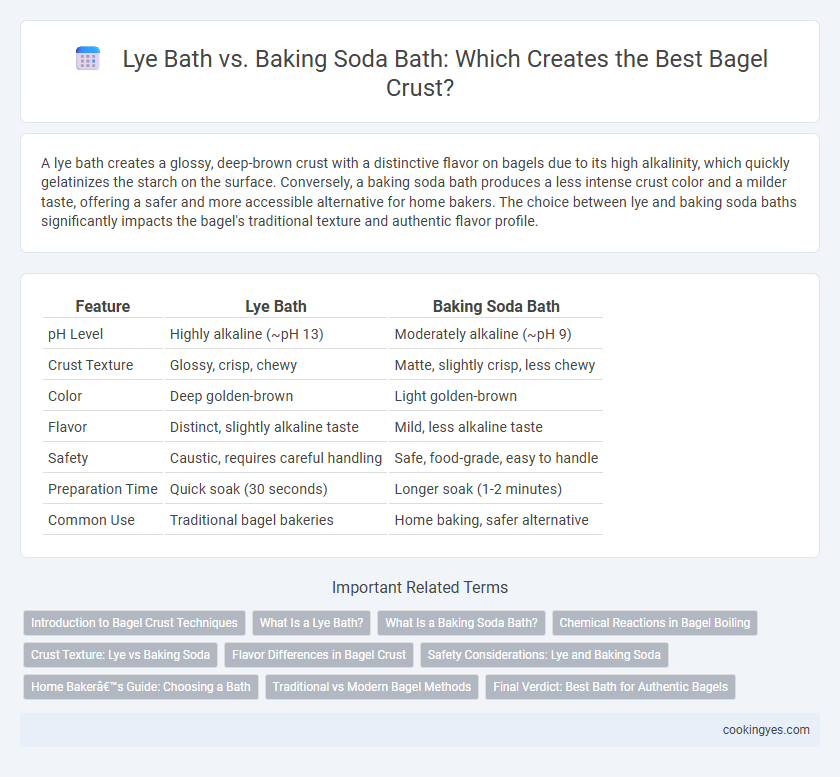A lye bath creates a glossy, deep-brown crust with a distinctive flavor on bagels due to its high alkalinity, which quickly gelatinizes the starch on the surface. Conversely, a baking soda bath produces a less intense crust color and a milder taste, offering a safer and more accessible alternative for home bakers. The choice between lye and baking soda baths significantly impacts the bagel's traditional texture and authentic flavor profile.
Table of Comparison
| Feature | Lye Bath | Baking Soda Bath |
|---|---|---|
| pH Level | Highly alkaline (~pH 13) | Moderately alkaline (~pH 9) |
| Crust Texture | Glossy, crisp, chewy | Matte, slightly crisp, less chewy |
| Color | Deep golden-brown | Light golden-brown |
| Flavor | Distinct, slightly alkaline taste | Mild, less alkaline taste |
| Safety | Caustic, requires careful handling | Safe, food-grade, easy to handle |
| Preparation Time | Quick soak (30 seconds) | Longer soak (1-2 minutes) |
| Common Use | Traditional bagel bakeries | Home baking, safer alternative |
Introduction to Bagel Crust Techniques
The traditional bagel crust is achieved through the use of a lye bath, which creates a distinctively shiny, chewy, and slightly blistered exterior due to its high alkalinity promoting Maillard reaction. Baking soda baths serve as a safer alternative by raising pH levels less aggressively, resulting in a crust that is crisp yet less glossy and with a milder flavor. Understanding the chemical effects of these alkali baths is essential for mastering authentic bagel textures and appearances.
What Is a Lye Bath?
A lye bath, made from a sodium hydroxide solution, is a traditional method used to create the distinctive shiny, chewy crust on bagels by rapidly gelatinizing the starch on the surface. Unlike baking soda baths, which are milder and raise the pH to enhance browning, lye baths produce a deeper color and characteristic texture due to their stronger alkaline nature. This chemical treatment is essential for authentic bagels, contributing to their unique flavor and appearance.
What Is a Baking Soda Bath?
A baking soda bath for bagels involves boiling the dough briefly in water mixed with baking soda, which raises the pH level to create a slightly alkaline environment. This process helps develop a chewy crust and enhances browning through the Maillard reaction, similar to the effect of a traditional lye bath. Baking soda is a safer alternative to lye and still produces a distinctive crust texture and color, though it may be less intensely glossy and slightly different in flavor.
Chemical Reactions in Bagel Boiling
Lye baths create a highly alkaline environment (pH around 12-13), triggering Maillard reactions and caramelization that produce a deep brown, glossy bagel crust with distinctive flavor. Baking soda baths, with a milder alkalinity (pH around 9-10), induce less intense Maillard browning and result in a lighter, less crisp crust. The chemical reactions during boiling control crust texture and color by altering protein structure and surface sugars.
Crust Texture: Lye vs Baking Soda
Lye bath creates a shiny, deeply caramelized crust with a distinctive chewiness due to its high alkalinity, which enhances the Maillard reaction during baking. Baking soda bath produces a lighter, less glossy crust with a milder flavor, resulting in a softer bite and less pronounced texture. The chemical properties of lye penetrate the dough surface more effectively, giving traditional bagels their characteristic firmness and crackly crust compared to the gentler effect of baking soda.
Flavor Differences in Bagel Crust
A lye bath produces a shiny, deeply browned crust with a distinctively crisp texture and a slightly alkaline, savory flavor that enhances the traditional bagel taste. Baking soda bath results in a less intense crust color and a milder flavor, delivering a softer bite with subtle sweetness. The choice between lye and baking soda significantly impacts the bagel's crust flavor profile and overall authenticity.
Safety Considerations: Lye and Baking Soda
A lye bath, typically using food-grade sodium hydroxide, creates the iconic shiny, chewy bagel crust but requires careful handling with protective gear due to its caustic nature that can cause chemical burns. Baking soda baths, made from sodium bicarbonate, offer a safer alternative with mild alkalinity and reduced hazard, though they produce a less pronounced crust texture and color. Both methods adjust the dough's pH to enhance Maillard reaction during baking, but safety protocols differ significantly, making baking soda preferable for home bakers while lye remains standard in commercial settings.
Home Baker’s Guide: Choosing a Bath
A lye bath creates a traditional, shiny, and chewy bagel crust by inducing the Maillard reaction more effectively than a baking soda bath, which yields a softer crust with less gloss. Home bakers prioritize safety and convenience, often opting for a baking soda bath as it is less caustic and easier to handle than lye. The choice between these baths depends on the desired crust texture, flavor depth, and available preparation time in the home kitchen.
Traditional vs Modern Bagel Methods
A traditional lye bath creates a uniquely shiny and chewy bagel crust due to its high alkalinity, which gelatinizes the starch on the surface more effectively than baking soda. Modern baking soda baths offer a safer, more accessible alternative with slightly less pronounced crust texture and color, making them popular for home bakers. The alkaline nature of lye promotes Maillard reactions during baking, resulting in the classic deep brown and glossy finish distinct to New York-style bagels.
Final Verdict: Best Bath for Authentic Bagels
Lye bath remains the gold standard for achieving authentic bagel crust, creating a glossy, chewy exterior with a distinctive flavor that baking soda baths cannot fully replicate. Baking soda offers a safer and more accessible alternative, producing a respectable crust with a slightly less pronounced texture and color. For genuine New York-style bagels, the alkaline strength of a lye bath is unmatched in delivering classic crust characteristics.
Lye Bath vs Baking Soda Bath for Bagel Crust Infographic

 cookingyes.com
cookingyes.com